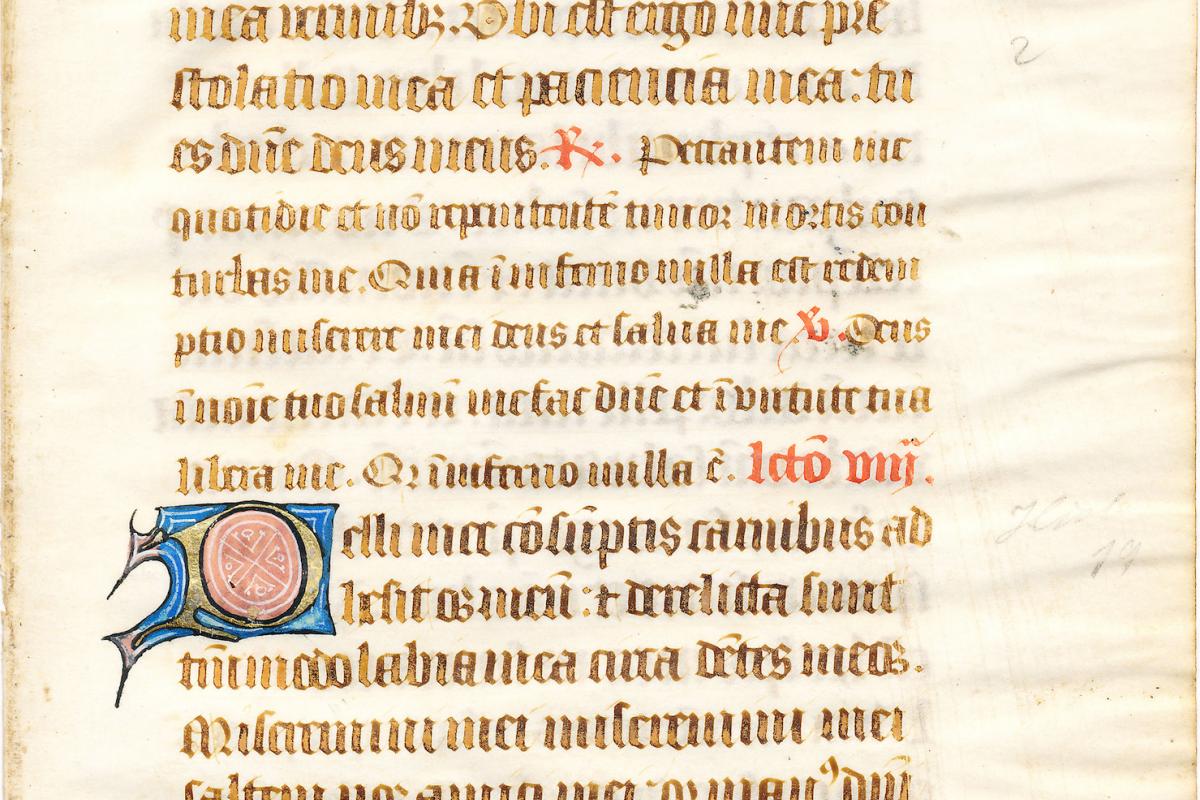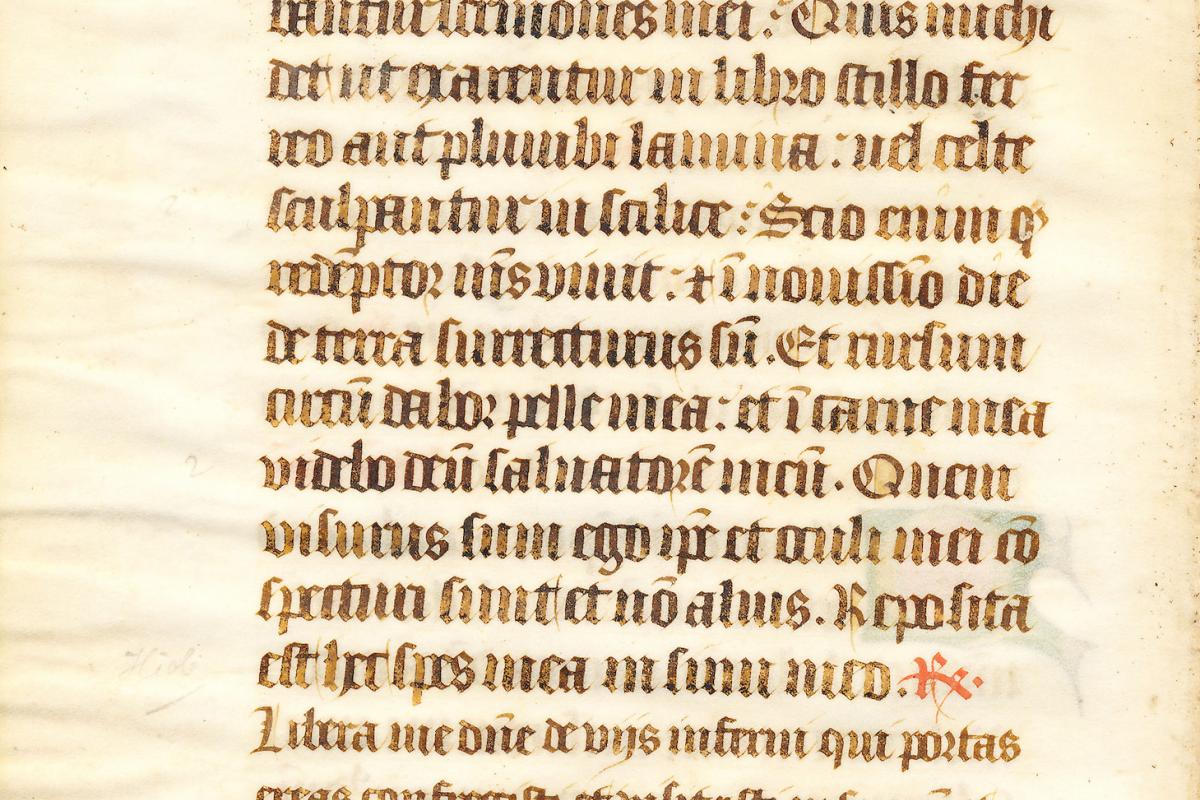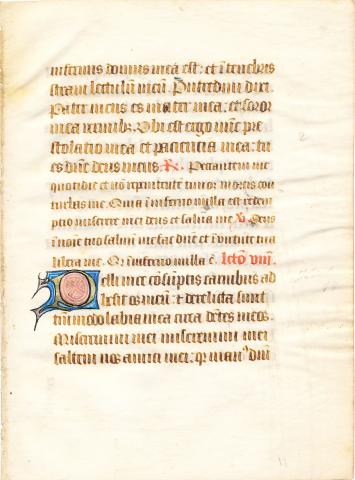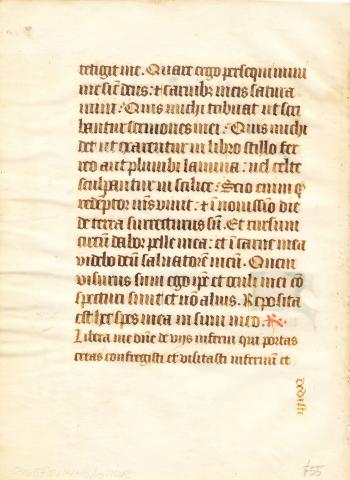Book of Hours Leaf
Book of Hours Leaf
French, ca. 1470
Language: Latin
ink on vellum
height 16.6 cm
width 12.2 cm
Portland State University Library Special Collections
Mss. 12, Rose-Wright Manuscript Collection no. 4
Erin C. Jones, Medieval Portland Capstone Student, 2008
Manuscript 12 in the Portland State University Special Collections is a single leaf from a modest Book of Hours. It has been dated circa 1470 and is posited to have originated in Northern France. The recto begins in the middle of the seventh lesson from the Matins in the Office of the Dead and the verso contains the eighth lesson in its entirety. Matins would have been read either very late at night or in the early hours of the morning. The Office of the Dead was a liturgy performed for the deceased. The ink is brown, the material is vellum, and the script is very angular and compressed, resembling Gothic Textura Quadrata, which was primarily used in France, Germany, and England. The text is in Latin; it is rare to find a devotional manuscript of the time in the vernacular language, particularly in France, although many secular manuscripts in the vernacular exist.
The Book of Hours was a private prayer book containing a number of services divided into the eight canonical hours of the day. By the 15th century, the Book of Hours had become the most common illuminated manuscript, reaching particular popularity in France. Because of its popularity, the Book of Hours is often referred to as the "medieval best seller."
15th-century France proved to be the leading center for manuscript illumination. Manuscript production suffered a downturn during the beginning of the Hundred Years' War (1337-1453), but with the reign of Charles V (or Charles the Wise), who collected a large number of manuscripts, the popularity of the arts expanded, placing France at the head of Europe. Since the 13th century, Paris had been highly regarded as the center for illumination, providing a model for the rest of Europe. But by the early 1400s, many illuminators moved out of Paris due to England's siege of the city and also a reoccurrence of the plague. Once the situation improved, many of these illuminators and scribes had already found success in other areas of France, particularly in Northern France, and did not return to Paris.
By the 15th century, manuscripts, the Book of Hours particularly, were bought not only by the nobles and royalty but also by the middle-class bourgeois. Books of Hours were so popular that almost all of the educated population would have owned them. The amount and style of illumination in a Book of Hours elucidates information about the owner. Books like the one from which the Portland State leaf came are more modest and likely were owned by a middle-class layperson.
For the most part, the Book of Hours consists of the Little Office of the Blessed Virgin Mary, a shorter and simpler simulation of the Divine Office. It was a common gift book that could be bought ready-made or ordered specifically by a patron. The Office of the Dead, from which this leaf belongs, was a popular, almost standard, addition to the Book of Hours. Because it was often special ordered, the patron could choose to add other devotional texts or highlight certain saints. Although there is a slight idiosyncrasy regarding the content of the leaf (it skips the response for the eighth lesson), it is more likely that a patron did not order the manuscript from which this leaf came.
The decoration of a particular page in a manuscript denotes the importance of the section. This is referred to as the hierarchy of decoration. Openings of particular Offices often would provide a much more embellished page, usually offering an illumination, decorative border, and large illuminated initial. Almost all Books of Hours from this period and location would have included at least one illuminated page with miniatures. MS 12 contains the beginning of a lesson, which in the hierarchy of decoration for this particular manuscript warrants a decorative initial and no elaborate illuminations.
The recto is sixteen lines containing three red abbreviations and the aforementioned decorative initial. The first red abbreviation marks the response, and the next red initial is the abbreviation for the versicle. The text of the versicle seems to be shortened as the repetition of the last line from the response above it has been omitted. The response and the versicle are both in a smaller script, which, along with the red abbreviations, likely aided the reader to quickly find them. After the versicle, there is a red abbreviation for the beginning of the eighth lesson.
The first letter of the eighth lesson is the decorative initial "P." This is the most significant aspect of this modest leaf. Likely, besides what very general information can be learned from the script and vellum, the dating and provenance of this leaf have been deduced from analysis of the decoration on this initial. The initial is in burnished gold with a cusped angular blue border outlined in black, and a rose-colored interior. The blue border contains fine white filigree, as does the rose-colored interior. The interior filigree is a symmetrical geometric pattern, and the exterior filigree replicates the contours of the black border.
This decorative initial is almost identical to many initials found in manuscripts from mid to late 15th-century Northern France. The colors red and blue were the most popular colors in all manuscripts, the geometric shaping, and particularly the use of burnished gold with a blue border and red/rose interior, or a red border and blue interior, with white filigree coheres strongly to this time period and location.
The verso of the page contains the eighth lesson in its entirety, and the red initial marks the beginning of the response. But the response provided is actually the response for the ninth lesson, meaning the scribe either purposefully or accidentally provided the response for the ninth lesson instead of the response for the eighth. Many Books of Hours contained shortened versions of the Office of the Dead, which may be the case with Ms. 12, or it could be an error made by the scribe. But the rubric for the response is different than the symbol on the recto, and therefore may be a signal of the omission instead of an abbreviation for the response.
Another idiosyncrasy is found with the catchphrase at the bottom right corner. The catchphrase marks the end of a gathering or quire, which ordered the pages for binding thus eradicating any possible confusion if the work became disarranged. Although some manuscripts used numbers, the catchphrase of MS 12 is the first word of the next page, which was a common practice. Oddly, on MS 2 the catchphrase is vertical as opposed to horizontal, which is very rare and almost always found in 15th-century Italy, although nothing else in the manuscript suggests it came from Italy.
Although MS12 is a modest leaf, the writing and the decorative initial are clear and neat, and the page itself is in relatively good shape. The date and provenance of the leaf are roughly based on a few indications, specifically the decorative initial, the type of script, and the simple fact that the leaf is from the Book of Hours, which all correlate well with mid to late 15th-century Northern France. Because of its modest nature, the manuscript was likely bought ready-made by a middle-class layperson and used for private devotion.
Suggestions For Further Reading:
Avrin, Leila. Scribes, Script, and Books: The Book Arts from Antiquity to the Renaissance. Chicago: American Library Association, 1991.
Backhouse, Janet. Books of Hours. Dover: British Library, 1985.
De Hamel, Christopher. Scribes and Illuminators. Toronto: University of Toronto Press, 1992.
Diringer, David. The Illuminated Book: Its History and Production. New York: Philosophical Library, 1958.
Toulet, Emmanuelle, ed. L'enluminure en France au temps de Jean Fouquet. Paris: Somogy editions d'art, 2003.
Dr. Wilma Fitzgerald, SP, quoted with permission from an unpublished study
Liber horarum. Officium defunctorum. Ad matutinum, lect. vii-viii, versus et resp. Saec. XV ex. N. France [?]. One leaf 166 x 122 (100 x 75) mm., 1 col. 16 lines. Catch word: dedisti in right margin verso side. One gold two-line initial on blue ground. Sales catalogue number: 5465f 244h5/1511UR [Pirages of McMinnville, Oregon].
// [Lectio vii: Spiritus [Iob 17, 1-3 and 11-15] meus attenuabitur dies mei breviabuntur ... Si sustinuero] infernus domus mea est et in tenebris straui lectulum meum. Putredini dixi: Pater meus es mater mea et soror mea uermibus ubi est ergo nunc prestolatio mea et pacienciam meam tu es domine deus meus .../.... R. Libera me domine de uiis inferni qui porta aereas confregisti et uisitasti infernum et [dedisti eis lumen ut uiderent te. Qui erant in poenis tenebrarum.] //




